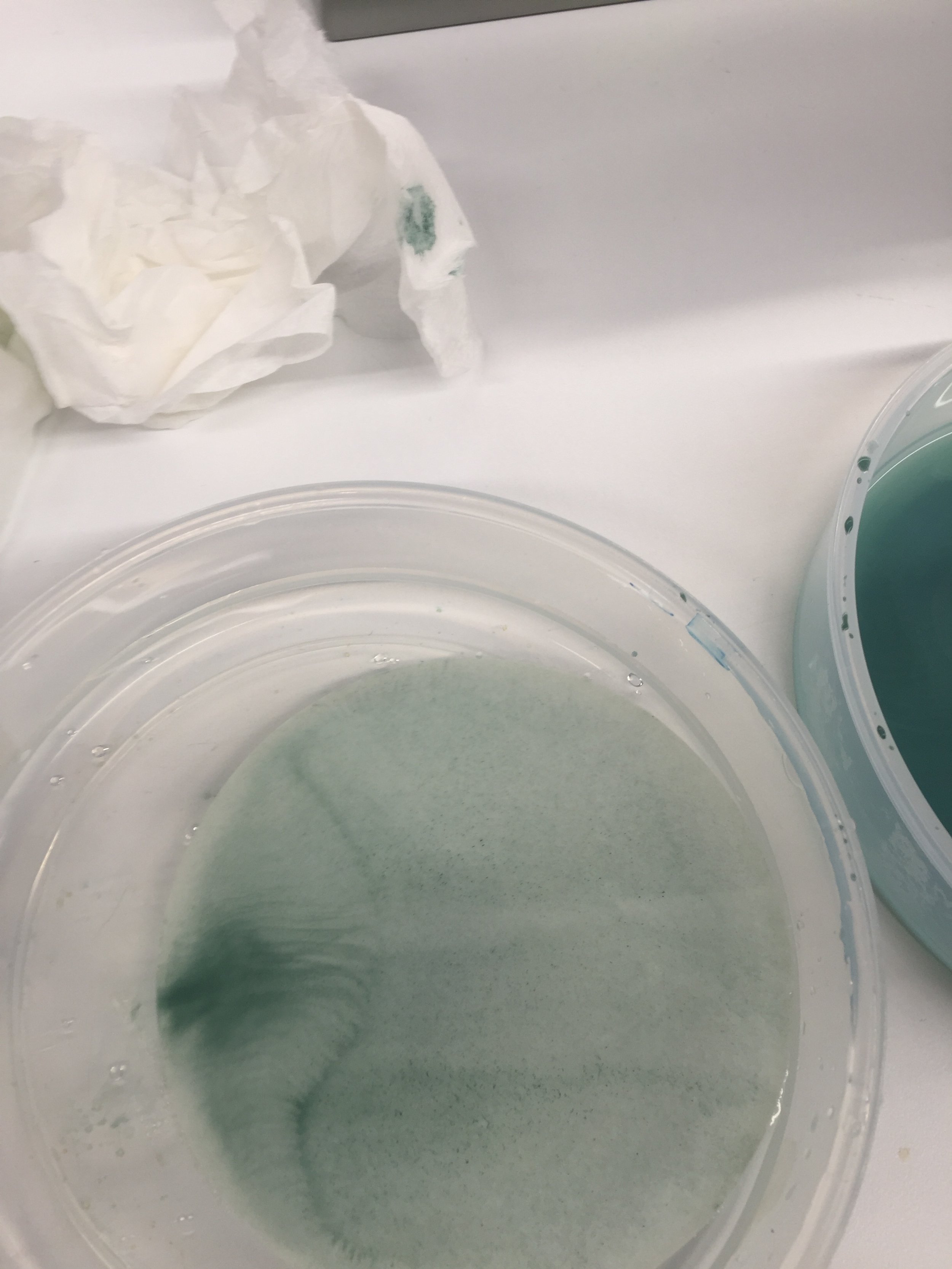GREEN VERDIGRIS (ZANGĀRĪ) COLOUR DYE RECIPES
At least eight sources have been described the colouring of paper with green copper pigment (zangār) to be used as dye for purpose of dyeing paper. The first two sources: Resaleh-ye Joharrieh (1120 A.H./1708 A.D.) and Resāleh Dar Bayān-e Kāğaḏ Morakkab va Ḥall-e Alvān both in 15th centuy, the recipes are the same:
رنگِ زنگاری خوب را که از ورق مس و سرکهٔ کهنه حاصل شده یاشد در کاسهٔ چینی به سرکه صلایه کند تا هیچ جرم در وی نماند، پس هر یک سیرِ زنگار را ده سیر آب بیامیزد و یک شبانروز بنهد و سر بپوشد تا گرد و خاک به وی نرسد، بعد از آن صافی آن را بگیرد و کاغذ بدان رنگ کند
Take good-quality copper green pigment (zangār), which is made by corroding copper sheets with vinegar. Place it in a China bowl, add vinegar, and grind it until no particles are left. For each one sīr zangār, add ten sīrs water. Tighten the lid to protect it from dust and dirt. Keep it for one full day. Then filter it and dye paper with it..
Resāleh Dar Maʿrefat-e Kāğaḏ-e Alvān (19th century) by anonymeous author reads:
قدری زنگارِ خوب را که از مس گرفته باشند با سرکه در کاسه صلایه کند، تا آنگاه که هیچ جرمی در وی نمانده باشد، پس هر یک سیرِ زنگار را ده سیر آب بیامیزد و سرش بپوشد تا گرد و خاک بر وی ننشیند، و یک شبانروز بگذارد که بعد از آن به آب صاف آن کاغذ را رنگ کند، بغایت خوب است
Take good-quality zangār, which is made by corroding copper sheets with vinegar. Place it in a China bowl, add vinegar, and grind it until no particles are left. For each one sīr zangār, add ten sīrs water. Tighten the lid to protect from dust and dirt. Keep it for one full day to settle, and all remaining particles will precipitate. Then filter it to obtain a clear solution and dye paper with it. Nice green paper will be obtained.
In another two sources, Hossein Aqili Rostamdari in Kaṭ va Morakkab (978 A.H./1571 A.D.). in 16th century and anonymeous author in Resāleh Dar Bayān-e Rang Kardan-e Kāğaḏ in 19th century, describe specifically the recipes for obtaining good quality of copper green (zangar) to be used as dye. In Kaṭ va Morakkab in 16th century, Hossein Aqilī Rostamdari explains the technique as follows:
چون کسی خواهد که رنگ زنگاری کند باید که طبقی از مس بر بالای ظرف سرکه نهد چند روز که زنگار بگیرد و بعد از آن آن زنگار را در کاسهٔ چینی از سرکه حل کند، بعد از آن به یک سیراز زنگار حل کرده ده سیر آب بریزد و سرِ او را بپوشد یک شبانه روز، بعد از آن بیرون آورد و صافی از آن رنگ را جدا سازد هرچه خواهد در او رنگ کند
If anyone desires to dye with copper green (zangār), they must place a tray of copper pieces over vinegar for a few days until zangār is obtained. Then the obtained zangār is mixed with vinegar in a China bowl to react and make a suspension. Then, for each one sīr of zangar and vinegar suspension, ten sīrs of water are added, followed by closing the lid for a full day. Then filter it to obtain a clear dye, and whatever is desired is dyed in it.
The other two source, Resāleh-ye khošnevīsī (1120 A.H./1708 A.D.) in 18th century and Resāleh Dar Bayān-e Rang Kardan-e Kāğaḏ in 19th century, it is advised to add sal ammoniac for obtaining good quality zangār for dyeing paper:
اوٌل گرفتن زنگار، یک رطل نوشادر نیم رطل برادهٔ مس در کاسه ای کن، و اندک سرکهٔ انگوری در برادهٔ آهن بچکان، و چوبی که سرِ او پهن باشد در آن کاسه صلایه می کن، تا وقتی که زنگارش از رق حاصل شود، و در وقت رنگ اندکی آب به او همراه ساز تا که رنگ کردن کاغذ کاغذ را در همان آب زنگار کشیده خشک نماید، زنگاری اعلی خواهد بود
First, make copper green (zangār) by taking one raṭl sal ammoniac and half a ratl copper pieces, and place them in a bowl. Drop a little amount of grape vinegar over it and bray it with a wooden stick with a wide tip until zangār is obtained. In the time of dyeing, add water to it, dip paper, and then dry. This way, a good quality of zangār will be obtained.
[1] raṭl = 1/2 mann, equivalent to 1,5 kg or 1,500 grams. Mann is a measure for dry goods; a weight of 3 kg (3,000 grams) or 40 sers (one ser is equivalent to 75 grams).
Experiment:
Start by taking 5 grams of copper green verdigris and grind it into a fine powder. Add 50 ml of water and stir the mixture thoroughly. Allow it to settle by closing the lid for a full day, and then filter it to obtain a clear dye. Transfer the clear dye to a glass container. Dip the paper into the dye to achieve the desired color tone. For lighter or darker green shades, adjust the concentration of the dye by adding or reducing it. Remove the paper from the dye bath and let it dry in the shade.





